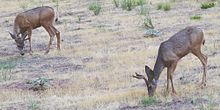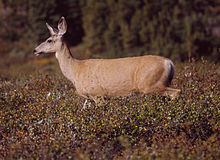- Mule deer
-
Mule Deer[1] 
Mule deer male and female in Modoc County, California Conservation status Scientific classification 
Kingdom: Animalia Phylum: Chordata Class: Mammalia Order: Artiodactyla Family: Cervidae Genus: Odocoileus Species: O. hemionus Binomial name Odocoileus hemionus
(Rafinesque, 1817)Subspecies 10, but some disputed (see text)
The mule deer (Odocoileus hemionus) is a deer indigenous to western North America. The Mule Deer gets its name from its large mule-like ears. There are believed to be several subspecies, including the black-tailed deer.[2][3][4][5][6][7] Unlike its cousin, the white-tailed deer, mule deer are generally more associated with the land west of the Missouri River, or more specifically, with the Rocky Mountain region of North America. Mule deer have also been introduced to Kauai (Hawaii) and Argentina.[3] The most noticeable differences between whitetails and mule deer are the size of their ears, the color of their tails, and the configuration of their antlers. In many cases, body size is also a key difference. The mule deer's tail is black-tipped, whereas the whitetail's is not. Mule deer antlers are bifurcated; in other words, they "fork" as they grow, rather than branching from a single main beam, as is the case with whitetails. Each spring, after mating season, a buck's antlers start to regrow almost immediately after the old antlers are shed. Shedding typically takes place in mid February, with variations occurring by locale. Although capable of running, mule deer often prefer to stot, with all four feet coming down together.
The mule deer is the largest of the Odocoileus genus, standing, on the average, 40–42 inches (100–110 cm) at the shoulders and stretching 80 inches (200 cm) or so nose to tail. An adult buck will weigh from 150–300 pounds (68–140 kg) on the hoof, with does averaging 125–175 pounds (57–79 kg). The occasional trophy-sized mule deer buck may weigh in around 500 pounds (230 kg).[1] The Mule Deer does not show marked size variation across its range, as does the White-tailed Deer.
Contents
Seasonal behaviors
In addition to movements related to available shelter and food, the breeding cycle is important in understanding deer behavior. The "rut" or mating season usually begins in the fall as does go into estrus for a period of a few days and males become more aggressive, competing for mates. Does may mate with more than one buck and go back into estrus within a month if they do not settle. The gestation period is about 190–200 days, with fawns born in the spring, staying with their mothers during the summer and being weaned in the fall after about 60–75 days. A buck's antlers fall off during the winter, to grow again in preparation for the next season's rut. For more information see main article on deer.
There are several non-human predators of mule deer. Gray Wolves and mountain lions are the main predator of adult deer. Bobcats, Coyotes, American Black Bears and Grizzly Bears less commonly prey on adult deer, though commonly attack fawns.[8]
Foraging
In summer, it chiefly forages on not only herbaceous plants, but also various berries (including blackberry, blueberry, salal, and thimbleberry). Mule deer are known to forage in summer on California Buckeye leaves, even though there is some evidence of that plant's toxicity.[9]
 Mule Deer grazing in Zion National Park
Mule Deer grazing in Zion National Park
 A Mule Deer buck grazing near Leavenworth, Washington
A Mule Deer buck grazing near Leavenworth, Washington
 A Mule Deer doe grazing in Alberta, Canada
A Mule Deer doe grazing in Alberta, Canada
In winter, it forages on conifers (especially Douglas fir, cedar, Taxus yews, juniper), and twigs of deciduous trees and shrubs (esp. aspen, willow, dogwood, serviceberry, and sage). In season, it eats acorns and apples. Over much of its range, snow and ice cover many food sources and the food that is accessible grows slower. Its metabolism slows and it becomes less active to survive in an environment with less food. A large fraction of the deaths in mule deer population occur in the winter, especially during the first year of life.
During the winter, most mule deer must move down from mountains, where the snow is deeper and covers most of the food, into the valleys, where there is less snow. Sometimes, in response to perceived distress, concerned people create feeding programs. Such supplemental feeding efforts may be harmful if not properly implemented.[10]
Mule deer prefer to eat high amounts of fresh grass and populations tend to move up or down with those of their preferred foods. Mule deer rarely travel far from water or forage, and tend to bed down within easy walking distance of both. Young mule deer tend to forage together in family groups while bucks tend to travel alone or with other bucks. Most actively foraging around dawn and dusk, they tend to bed down in protected areas mid-day, but will also forage at night in more open agricultural areas, during full moons, or when pressured by hunters. Repeated beds will often be scratched level, about the size of a washtub. Temporary beds will seem little more than flattened grassy grounds.
Taxonomy
The mule deer can be divided into two main groups: The mule deer (sensu stricto) and the black-tailed deer. The first group includes all subspecies, except O. h. columbianus and O. h. sitkensis, which both are in the black-tailed deer group.[3] The two main groups have been treated as separate species, but they hybridize, and virtually all recent authorities treat the mule deer and black-tailed deer as conspecific.[2][3][4][5][7][11] It appears the mule deer evolved from the black-tailed deer.[7] Despite this, the mtDNA of the white-tailed deer and mule deer is similar, but differs from that of the black-tailed deer.[7] This may be the result of introgression, although hybrids between the mule deer and white-tailed deer are rare in the wild (apparently more common locally in west Texas), and the hybrid survival rate is low even in captivity.[6][7] Many claims of observations of wild hybrids are not legitimate, as identification based on external features is complicated.[6]
Survival
The major enemies of this deer are humans driving automobiles or hunting them, and their top predators are large carnivores such as mountain lions, black bears and coyotes. Mule deer are not well equipped for fighting back, so they rely on speed and being alert to avoid predation and human-inflicted harm.
Subspecies
 Distribution map of seven mule deer subspecies:
Distribution map of seven mule deer subspecies: Sitka black-tailed deer (O. h. sitkensis)Black-tailed deer (O. h. columbianus)California mule deer (O. h. californicus)Southern mule deer (O. h. fuliginatus)Peninsula mule deer (O. h. peninsulae)Desert mule deer (O. h. eremicus)Rocky Mountain mule deer (O. h. hemionus)
Sitka black-tailed deer (O. h. sitkensis)Black-tailed deer (O. h. columbianus)California mule deer (O. h. californicus)Southern mule deer (O. h. fuliginatus)Peninsula mule deer (O. h. peninsulae)Desert mule deer (O. h. eremicus)Rocky Mountain mule deer (O. h. hemionus)Some authorities have recognized O. h. crooki as a senior synonym of O. h. eremicus, but the type specimen of the former is a hybrid between the mule deer and white-tailed deer, and the name O. h. crooki is therefore invalid.[3][12] Additionally, the validity of O. h. inyoensis has been questioned, and the two insular O. h. cerrosensis and O. h. sheldoni may be synonyms of O. h. eremicus or O. h. peninsulae.[11]
The 10 valid subspecies based on the 3rd edition of Mammal Species of the World are:[3]
- Mule deer (sensu stricto) group:
- O. h. californicus – California mule deer
- O. h. cerrosensis – Cedros/Cerros Island mule deer (Cedros Island)
- O. h. eremicus – Desert/burro mule deer (northwest Mexico and Arizona)
- O. h. fuliginatus – Southern mule deer (southernmost California and Baja California)
- O. h. hemionus – Rocky Mountain mule deer (western and central North America)
- O. h. inyoensis – Inyo mule deer (Sierra Nevada, California)
- O. h. peninsulae – Peninsula mule deer (Baja California Sur)
- O. h. sheldoni – Tiburon Island mule deer (Tiburon Island)
- Black-tailed deer group:
- O. h. columbianus – Black-tailed deer (Pacific Northwest and Northern California regions)
- O. h. sitkensis – Sitka black-tailed deer (coastal area and islands off western British Columbia)
References
- ^ "Odocoileus hemionus". Integrated Taxonomic Information System. http://www.itis.gov/servlet/SingleRpt/SingleRpt?search_topic=TSN&search_value=180698. Retrieved 23 March 2006.
- ^ a b c Sanchez Rojas, G. & Gallina Tessaro, S. (2008). Odocoileus hemionus. In: IUCN 2008. IUCN Red List of Threatened Species. Downloaded on 8 April 2009. Database entry includes a brief justification of why this species is of least concern.
- ^ a b c d e f Wilson, Don E.; Reeder, DeeAnn M., eds (2005). Mammal Species of the World (3rd ed.). Baltimore: Johns Hopkins University Press, 2 vols. (2142 pp.). ISBN 978-0-8018-8221-0. OCLC 62265494. http://www.bucknell.edu/msw3/browse.asp?id=14200267.
- ^ a b Novak, R. M. (1999). Walker's Mammals of the World. 6th edition. ISBN 0-8018-5789-9
- ^ a b Reid, F. A. (2006). Mammals of North America. 4th edition. ISBN 978-0-395-93596-5
- ^ a b c Heffelfinger, J. (Ver. 2, March 2011). Tails with a dark side: The truth about whitetail - mule deer hybrids.
- ^ a b c d e Geist, V. (1998). Deer of the world: their evolution, behaviour, and ecology. ISBN 978-0811704960
- ^ Odocoileus hemionus, Animal Diversity
- ^ C.Michael Hogan (2008) Aesculus californica, Globaltwitcher.com, ed. N. Stromberg
- ^ http://www.dfg.ca.gov/wildlife/hunting/deer/docs/NAMuleDeerConsPlanFinal.pdf
- ^ a b Feldhamer, G. A., B. C. Thompson, and J. A. Chapman, editors (2003). Wild mammals of North America: biology, management, and conservation. 2nd edition. ISBN 978-0801874161
- ^ Heffelfinger, J. (2000). Status of the name Odocoileus hemionus crooki (Mammalia: Cervidae). Proceedings of the Biological Society of Washington 113: 319-333
External links
Categories:- IUCN Red List least concern species
- Deer
- Mammals of North America
- Mammals of the United States
- Megafauna of North America
- Fauna of the Western United States
- Fauna of the California chaparral and woodlands
- Fauna of the Sierra Nevada (U.S.)
- Fauna of the Rocky Mountains
- Introduced mammals of Hawaii
- Mule deer (sensu stricto) group:
Wikimedia Foundation. 2010.

